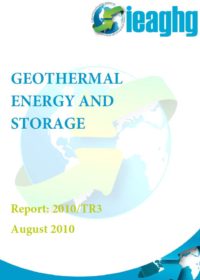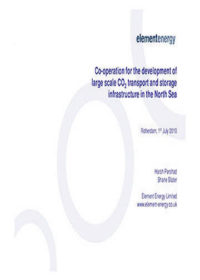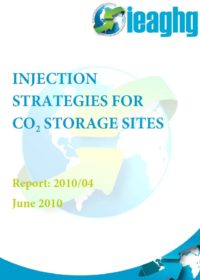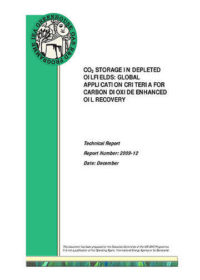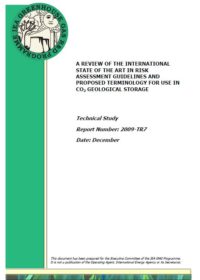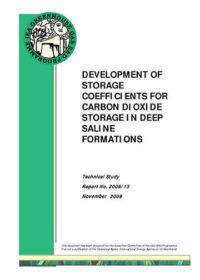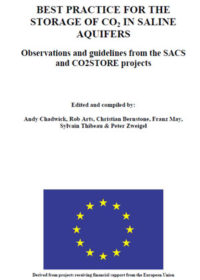Resources
Publications
Our publications, reports and research library hosts over 500 specialist reports and research papers on all topics associated with CCS.
View our Publication Library Disclaimer.
Filter by
In Salah CO2 Storage JIP: site selection, management, field development plan and monitoring overview
1st September 2010
Topic(s): Carbon capture use and storage (CCUS), CO2 storage, Engineering and project delivery
This paper presents information on the Joint Industry Project (JIP) established to monitor CO2 storage at the In Salah geologic carbon sequestration (GCS) project in Algeria. Site selection was guided by the standard oil-industry Capital Value Process (CVP). After four years of injection and monitoring, a Quantified Risk Assessment (QRA) was performed to update the development plan. Monitoring included satellite facilitated measurements of surface deformation, as well as conventional oilfield technologies.
Disclaimer
The content within the Global CCS Institute Publications, Reports and Research Library is provided for information purposes only. We make every effort and take reasonable care to keep the content of this section up-to-date and error-free. However, we make no claim as to its accuracy, currency or reliability.
Content and material featured within this section of our website includes reports and research published by third parties. The content and material may include opinions and recommendations of third parties that do not reflect those held by the Global CCS Institute.
In Salah CO2 storage JIP: carbon dioxide plume extension around KB-502 well. New insights into reservoir behaviour at the In Salah storage site
1st September 2010
Topic(s): CO2 storage, Engineering and project delivery
This paper presents information by the Joint Industry Project established to monitor CO2 storage at the In Salah geologic carbon sequestration (GCS) project in Algeria. Satellite-based interferometry (InSAR) technology detected surface uplift over all three horizontal CO2 injection wells shortly after the start of CO2 injection. Imperial College London carried out simulations of CO2 injection aiming to gain a better understanding of the reservoir behaviour. The findings are reported in this paper.
Disclaimer
The content within the Global CCS Institute Publications, Reports and Research Library is provided for information purposes only. We make every effort and take reasonable care to keep the content of this section up-to-date and error-free. However, we make no claim as to its accuracy, currency or reliability.
Content and material featured within this section of our website includes reports and research published by third parties. The content and material may include opinions and recommendations of third parties that do not reflect those held by the Global CCS Institute.
In Salah CO2 Storage JIP: CO2 sequestration monitoring and verification technologies applied at Krechba, Algeria
1st September 2010
Topic(s): Carbon capture use and storage (CCUS), CO2 storage, Engineering and project delivery
This paper presents information by the Joint Industry Project established to monitor CO2 storage at the In Salah geologic carbon sequestration (GCS) project in Algeria. This paper is limited to the first five years of monitoring. The authors describe their use of the Boston Square to compare diverse technologies, followed by a discussion of current JIP monitoring and verification technologies in use at Krechba. The report concludes with a summary of monitoring results to date.
Allan Mathieson, corresponing author:allan.mathieson@uk.bp.com
Disclaimer
The content within the Global CCS Institute Publications, Reports and Research Library is provided for information purposes only. We make every effort and take reasonable care to keep the content of this section up-to-date and error-free. However, we make no claim as to its accuracy, currency or reliability.
Content and material featured within this section of our website includes reports and research published by third parties. The content and material may include opinions and recommendations of third parties that do not reflect those held by the Global CCS Institute.
In Salah CO2 Storage JIP: hydromechanical simulations of surface uplift due to CO2 injection at In Salah
1st September 2010
Topic(s): Carbon capture use and storage (CCUS), CO2 storage, Engineering and project delivery
This paper presents information by the Joint Industry Project established to monitor CO2 storage at the In Salah geologic carbon sequestration (GCS) project in Algeria. This study describes detailed simulations of the hydromechanical response in the vicinity of the KB-502 CO2 injector in an attempt to explain why the morphology of the observed surface deformation differed from that above the other injectors at the field.
Disclaimer
The content within the Global CCS Institute Publications, Reports and Research Library is provided for information purposes only. We make every effort and take reasonable care to keep the content of this section up-to-date and error-free. However, we make no claim as to its accuracy, currency or reliability.
Content and material featured within this section of our website includes reports and research published by third parties. The content and material may include opinions and recommendations of third parties that do not reflect those held by the Global CCS Institute.
Geothermal energy and storage
3rd August 2010
Topic(s): Carbon capture use and storage (CCUS), CO2 storage, Geothermal energy, Renewables
The aim of the report is to establish what the possible conflicts and synergies are between the geological storage of carbon dioxide and geothermal energy.
Disclaimer
The content within the Global CCS Institute Publications, Reports and Research Library is provided for information purposes only. We make every effort and take reasonable care to keep the content of this section up-to-date and error-free. However, we make no claim as to its accuracy, currency or reliability.
Content and material featured within this section of our website includes reports and research published by third parties. The content and material may include opinions and recommendations of third parties that do not reflect those held by the Global CCS Institute.
Co-operation for the development of large scale CO2 transport and storage infrastructure in the North Sea
1st July 2010
Topic(s): CO2 storage, CO2 transport
Disclaimer
The content within the Global CCS Institute Publications, Reports and Research Library is provided for information purposes only. We make every effort and take reasonable care to keep the content of this section up-to-date and error-free. However, we make no claim as to its accuracy, currency or reliability.
Content and material featured within this section of our website includes reports and research published by third parties. The content and material may include opinions and recommendations of third parties that do not reflect those held by the Global CCS Institute.
Injection strategies for CO2 storage sites
4th June 2010
Topic(s): Carbon capture use and storage (CCUS), CO2 storage
Injecting carbon dioxide (CO2) into either deep saline aquifers, depleted hydrocarbon reservoirs or deep, un-minable coal seams is a promising option for the geological storage of CO2 in order to reduce anthropogenic greenhouse gas emissions into the atmosphere. Previous studies and the experience from existing storage and enhanced oil recovery operations have shown that the technology and well design for carbon dioxide injection is well developed (Cooper, 2009). In addition, many studies all over the world have concluded that there is sufficient potential storage capacity in sedimentary basins for storing the global carbon dioxide emissions from industrial point sources (Bradshaw et al., 2007; Bradshaw and Dance, 2005; Li et al., 2005; USDOE, 2007). However, the current portfolio of storage operations does not sufficiently cover different geological environments and, more importantly, there is no experience with injection volumes much larger than 1 Mt CO2/year. At the same time, there are many uncertainties regarding the extent to which potential capacity can be turned into useable storage capacity, particularly when planning to inject large volumes in the order of several megatonnes of carbon dioxide that require multiple injection wells. It is now commonly accepted that, for geological storage to be an effective greenhouse mitigation option, the infrastructure (platforms, wells, pipelines, compressors) for injecting carbon dioxide will have to be at least on the order of magnitude of current petroleum installations. Also, injectivity of geological formations at an adequate distance from industrial point sources may be of lesser quality than has been encountered in existing projects. Reservoir quality information is particularly sparse for deep saline aquifers, resulting in large uncertainties in storage capacity estimations and forecasting of injectivity and sweep efficiency. In most cases, it can be expected that the CO2 injection scheme will have to consist of multiple wells, potentially including wells for monitoring and pressure control. Therefore, it is critical to develop efficient and cost-effective injection strategies that minimize the amount of wells and maximise the injection volume and injectivity.
Disclaimer
The content within the Global CCS Institute Publications, Reports and Research Library is provided for information purposes only. We make every effort and take reasonable care to keep the content of this section up-to-date and error-free. However, we make no claim as to its accuracy, currency or reliability.
Content and material featured within this section of our website includes reports and research published by third parties. The content and material may include opinions and recommendations of third parties that do not reflect those held by the Global CCS Institute.
CO2 sequestration monitoring and verification technologies applied at Krechba, Algeria
1st February 2010
Topic(s): Carbon capture use and storage (CCUS), CO2 storage, Engineering and project delivery
Disclaimer
The content within the Global CCS Institute Publications, Reports and Research Library is provided for information purposes only. We make every effort and take reasonable care to keep the content of this section up-to-date and error-free. However, we make no claim as to its accuracy, currency or reliability.
Content and material featured within this section of our website includes reports and research published by third parties. The content and material may include opinions and recommendations of third parties that do not reflect those held by the Global CCS Institute.
CO2 storage in depleted oilfields: global application criteria for carbon dioxide enhanced oil recovery
21st December 2009
Topic(s): Carbon capture use and storage (CCUS), CO2 storage, CO2 utilisation
The main aim of the study was to reassess the likely future potential storage capacity for CO2 in depleted oil fields as part of EOR operations across the world. The study also aimed to identify the key technical, economic and regulatory barriers that may be preventing widespread application of CO2-EOR globally as a means of providing an early opportunity for CO2 storage.
Previous IEA GHG studies estimated the global storage potential in depleted oil and gas fields as up to 1,000Gt CO2, 120Gt of which could be stored in association with CO2-EOR operations. Although therefore providing lower potential capacity than both deep saline formations and gas fields, depleted oilfields still constitute a valuable storage resource with extensive repositories of data and knowledge. Storage operations in oil fields would generally be smaller in scale compared to gas fields and aquifers, but the economic and commercial benefits of utilising CO2 for EOR could in theory provide an immediate driver for implementation of such projects, particularly in a period of high global oil prices. The stimulus of high oil process has led to the increasing development of CO2 flood operations in recent years, including at the Weyburn oil field in Canada which has extended the profitability of that field for the operator Encana.
IEA GHG thus identified CO2-EOR operations as an early opportunity for CO2 storage in 2002. However despite developments like those in the Permian Basin, midcontinental and Gulf Coast USA, and at Weyburn, wide scale global development of CO2-EOR has not occurred in spite of current high oil prices. Furthermore, a majority of existing CO2-EOR schemes have not been designed with CO2 storage as an objective. The aim of this study is to understand why this early opportunity for CO2 storage has not been realised and when or if this might occur.
Disclaimer
The content within the Global CCS Institute Publications, Reports and Research Library is provided for information purposes only. We make every effort and take reasonable care to keep the content of this section up-to-date and error-free. However, we make no claim as to its accuracy, currency or reliability.
Content and material featured within this section of our website includes reports and research published by third parties. The content and material may include opinions and recommendations of third parties that do not reflect those held by the Global CCS Institute.
A review of the international state of the art in risk assessment guidelines and proposed terminology for use in CO2 geological storage
17th December 2009
Topic(s): Carbon capture use and storage (CCUS), CO2 storage
The report includes an updated version of the risk management framework that incorporates the Framework for Risk Assessment and Management of Storage of CO2 Streams in Geological Formations (FRAM) and the European Union CO2 Capture and Storage (EU CCS) directive steps, which is also consistent with the human health and ecological risk assessment workflows, as well as the Standards Australian/ Standards New Zealand (AS/NZS) for environmental risk management and security risk management. The report also includes a comprehensive list of terms used in various risk publications and extensive reference list.
Disclaimer
The content within the Global CCS Institute Publications, Reports and Research Library is provided for information purposes only. We make every effort and take reasonable care to keep the content of this section up-to-date and error-free. However, we make no claim as to its accuracy, currency or reliability.
Content and material featured within this section of our website includes reports and research published by third parties. The content and material may include opinions and recommendations of third parties that do not reflect those held by the Global CCS Institute.
Development of storage coefficients for carbon dioxide storage in deep saline formations
17th November 2009
Topic(s): Carbon capture use and storage (CCUS), CO2 storage
Various Carbon Sequestration Leadership Forum (CSLF) and IEA GHG publications have documented the complexity associated with estimating storage resources, and the ability to represent the information in a manner that truly reflects and expresses the uncertainty involved. A key criteria that remains unresolved, is how to take theoretical resources and convert them to realistic or viable capacities at a regional level. Existing published papers state that “storage coefficients” need to be applied to regional estimates to achieve this. Such coefficients would be dependent on storage type (i.e. deep saline formations, depleted gas or oilfield) and geological characteristics of storage formations.
The aim of this study was to define a series of such coefficients, which can be applied to regional calculations to provide more realistic estimates. Coefficients were considered and derived principally for deep saline formations, reflecting the large storage potential but associated inherent complexity and uncertainty.
Disclaimer
The content within the Global CCS Institute Publications, Reports and Research Library is provided for information purposes only. We make every effort and take reasonable care to keep the content of this section up-to-date and error-free. However, we make no claim as to its accuracy, currency or reliability.
Content and material featured within this section of our website includes reports and research published by third parties. The content and material may include opinions and recommendations of third parties that do not reflect those held by the Global CCS Institute.
Best practice for the storage of CO2 in saline aquifers: observations and guidelines from the SACS and CO2STORE projects
6th November 2009
Topic(s): Carbon capture use and storage (CCUS), CO2 storage
Many of the research results from the SACS and CO2STORE projects are published in the scientific literature but in a somewhat disseminated form. This report aims to consolidate some of the key findings into a manual of observations and recommendations relevant to underground saline aquifer storage. The work builds upon and complements earlier best practice manuals from the SACS/SACS2 and GEO-SEQ projects (SACS, 2003; GEO-SEQ, 2004), and aims to provide technically robust guidelines for effective and safe CO2 storage in a range of geological settings. This will set the scene for companies, regulatory authorities, non-governmental organisations (NGOs), and ultimately the interested general public, in evaluating possible new CO2 storage projects in Europe and elsewhere.
Disclaimer
The content within the Global CCS Institute Publications, Reports and Research Library is provided for information purposes only. We make every effort and take reasonable care to keep the content of this section up-to-date and error-free. However, we make no claim as to its accuracy, currency or reliability.
Content and material featured within this section of our website includes reports and research published by third parties. The content and material may include opinions and recommendations of third parties that do not reflect those held by the Global CCS Institute.

